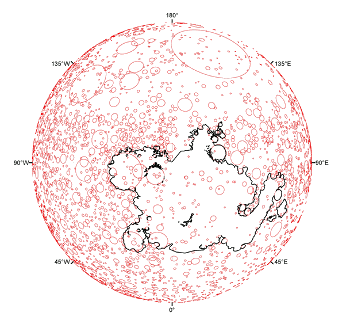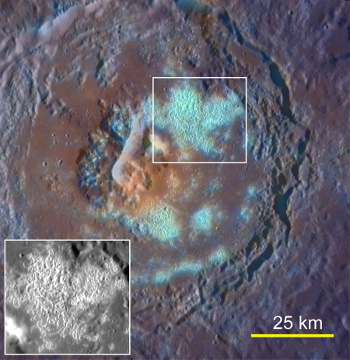Mirific Mercury
October 24, 2011
Mirific? I confess that I have never used that word before, but I wanted a catchy title. Mirific means wonderful, although the 1913 edition of
Webster's Unabridged Dictionary, now nicely in the
public domain, prefers mirifical.[1] This article is about the
planet Mercury, and not the
element, although
Kamerlingh Onnes may have exclaimed, "wonderlijk," the Dutch word for wonderful, when he
discovered the
superconductivity of the element in 1911.
NASA has taken a few lumps this year, notably for the controversy surrounding the "discovery" of
arsenic-based life that I wrote about in a
previous article (Arsenic-Based Life? January 5, 2011). NASA seems to be powerless to protect the most important
astronomy project of the decade, the
James Webb Space Telescope; and the end of the
Space Shuttle Program with no real successor has led to lay offs of about 7,000 NASA and contract employees.[2]
NASA still does a few things right, including its recent explorations of the
Moon[3],
Mars[4] and Mercury[5]. I wrote about the arrival of the MESSENGER Space Probe at Mercury in a
previous article (MESSENGER Space Probe at Mercury, March 15, 2011). Now, there's enough data for publication of a series of seven papers in
a special section of Science on September 30, 2011.[6-11]
The Science papers present high-resolution images, data on Mercury's
chemical and mineral composition, a possible
geologic history of the planet, and measurements of its
magnetic field. Mercury's magnetic field (300
nanoTesla) is just a percent of
Earth's magnetic field but, unlike the Earth, the field is aligned with the
spin axis. The
centroid of the core magnetic field is located about 480 km (298 miles) from the planet's center, so strange things are happening with the
fluid dynamics of the molten core[8, 10] Mercury has a mean radius of 2,440 km (1,516 miles), so the offset in core centroid position from the planet's center is quite large.
High resolution imagery of Mercury's surface shows that early
volcanism reshaped the planetary surface. Tremendous outpouring of
lava more than 3.5 billion years ago smoothed the region around Mercury's north pole by filling
craters with more than a mile's depth of lava. This lava outflow covered about six percent of Mercury's surface, or about 60% of the area of the
continental United States. [8-9]

Craters larger than 20 km in diameter around Mercury's north pole. The relatively crater-free region, as outlined, is about 4.7 million square kilometers, or more than 6% of the surface of Mercury
(NASA/Brown University Image))
The lava outflows were not from volcanoes, as on Earth, but from cracks in Mercury's surface.[7] Large vents can be seen at the perimeter of the lava flood plain, and such vents, now buried under lava, may have been the source of the lava flow.[11]
Another interesting surface feature revealed by MESSENGER's high resolution imagery has been termed, "hollows," by mission scientists. These irregularly shaped depressions appear in bright blue deposits, often found in clusters that have been exposed by meteor impact.[8,11] Mars has similar features, and these were caused by evaporating
carbon dioxide ice that leaves behind a hole in the ground. On Mercury, other volatile elements are expected to cause the same effect.[11]

Hollows in Tyagaraja, a 97 km diameter crater on Mercury.
Color has been enhanced on this image to better show the blue hollow regions. The orange material seems to have erupted from the feature in the center of the crater, which may be a volcanic vent.
(NASA Image))
Mercury's hollows occur in all areas of the planet, many have bright interiors and halos, and their lack of small impact craters indicates a young age.[8] Says David T. Blewett of the
Johns Hopkins University Applied Physics Laboratory, a lead author of one of the reports in Science, "Analysis of the images and estimates of the rate at which the hollows may be growing lead to the conclusion that they are actively forming today."[8]
MESSENGER's
X-ray and
gamma ray spectrometers show a high abundance of
sulfur and
potassium on Mercury. These elements
vaporize at relatively low temperatures, at least as far as Mercury is concerned.[7-8] The
boiling point of sulfur is 444.6°C, and that of potassium is 759°C). The volatile element content of Mercury appears to be similar to that of
Venus, Earth, and Mars. It is much larger than that of the Moon.[7] All this indicates that Mercury formed in the usual, planetary way.
References:
- The Online Plain Text English Dictionary.
- Marisa Krystian, "NASA's Space Shuttle Program Ends Cutting 7,000 Jobs at Kennedy Space Center," International Business Times, July 06, 2011.
- This Blog, "New Moon," October 25, 2010.
- This Blog, "Gale Crater," August 31, 2011.
- This Blog, "MESSENGER Space Probe at Mercury," March 15, 2011.
- Science, vol. 333, no. 6051 (30 September 2011), pp. 1785-1924 (Multiple reports on the Messenger Mission).
- Paulette Campbell, "Orbital Observations of Mercury Reveal Flood Lavas, Hollows, and Unprecedented Surface Details," Johns Hopkins University Applied Physics Laboratory Press Release, September 29, 2011.
- Mercury Not Like Other Planets MESSENGER Finds, Carnegie Institution Press Release, September 29, 2011.
- Richard Lewis, "Epic volcanic activity flooded Mercury's north polar region," Brown University Press Release, September 29, 2011.
- Amina Khan, "Messenger findings may 'revolutionize' views of Mercury," Los Angeles Times, September 30, 2011.
- Jonathan Amos, "'Hollows' mark Mercury's surface," BBC News, September 30, 2011
- NASA, MESSENGER Mission Official Web Site.
Permanent Link to this article
Linked Keywords: Webster's Unabridged Dictionary; public domain; planet Mercury; element mercury; Kamerlingh Onnes; superconductivity; NASA; arsenic; astronomy; James Webb Space Telescope; Space Shuttle Program; Moon; Mars; Science Journal; chemical and mineral composition; geologic; magnetic field; nanoTesla; Earth's magnetic field; spin axis; centroid; fluid dynamics; volcanism; lava; crater; continental United States; Brown University; carbon dioxide ice; Johns Hopkins University; Applied Physics Laboratory; X-ray; gamma ray; spectrometer; sulfur; potassium; vaporization; boiling point; Venus.